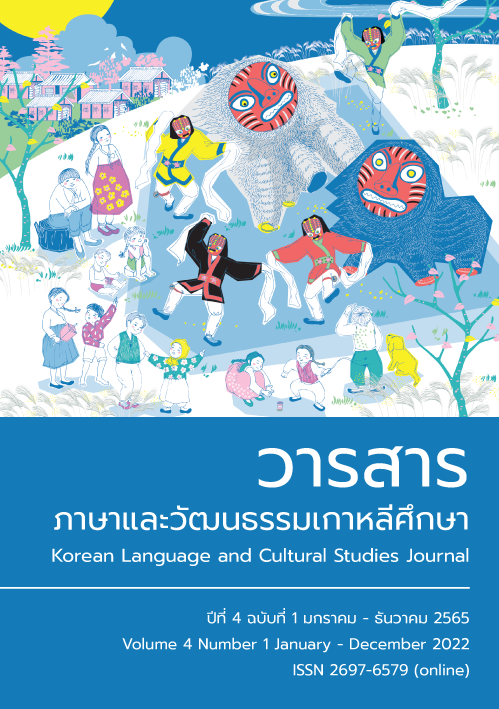A study on teaching methods for idiomatic expression using Korean drama: Focusing on Crash Landing on You
Main Article Content
Abstract
This study examines the importance of idiomatic expression education and the effectiveness of idiomatic expression education using dramas and tries to suggest a teaching method for idiomatic expressions using the world-famous Korean drama <Crash Landing on You>. Idiomatic expression education is very important because it can improve learners' communication skills and enhance their understanding of Korean culture. Since idiomatic expressions cannot be interpreted literally and are cultural vocabulary deeply involved in Korean culture, an efficient teaching method different from the existing memorization-style education is required. Through effective teaching, learners understand the practical meaning and context of idiomatic expressions and use them naturally. Drama can be a good teaching material for effective teaching of idiomatic expressions because it arouses the interest of learners and provides a discourse context close to real life. <Crash Landing on You> is valuable as an educational material because it not only reflects Korean culture well, but also contains various idiomatic expressions and is a well-known drama to learners from many countries. Among the idiomatic expressions shown in <Crash Landing on You>, expressions that can be effectively understood by the situation and context were selected and teaching methods for them were presented. Learners can infer the meaning of idiomatic expressions in the discourse context of drama material and improve their expression skills through activities such as dubbing.
Article Details
References
공하림, 손혜진. (2020). 문화 리터러시 관점에서 본 한국어 관용 표현 교육에 관한 고찰: 교재 분석을 중심으로. 문화와 융합, 42(5), 113-142.
김경숙, 라혜민. (2011). 뮤직비디오를 이용한 한국어•문화 교육 방안. 한국사상과 문화, 59, 473-496
김선정, 강현자. (2006). 한국어 관용어 교재 개발을 위한 기초 연구 및 단원 제시. 이중언어학, 32, 35-56.
김인구. (2020). K-드라마, 이젠 ‘넷류’다. 문화일보. Received August 8, 2022, from http://www.munhwa.com/news/view.html?no=2020060801031339179001
김중섭, 최은정. (2017). 한국 대중문화 노출이 취미 목적 한국어 학습자의 말하기에 미치는 영향. 한글, 318, 199-219.
나은주, 나은영. (2018). 더빙 프로젝트를 활용한 한국어 수업 사례 연구: 미국 대학생 학습자의 반응을 중심으로. 인문사회21, 9(4), 965-976.
민현식. (2003). 관용 표현의 범위와 유형에 대한 재고. 한국어 의미학, 12, 17-50.
서수백. (2016). 시트콤 자료를 활용한 한국어 관용 표현 교육 연구: 시트콤 <지붕뚫고 하이킥>을 대상으로. 인문논총, 41, 307-334.
손혜진, 임형옥, 공하림. (2018). TV 드라마 대본을 통한 한국어 관용표현의 사용 맥락 고찰. 학습자중심교과교육연구, 18(17), 319-340.
송대헌. (2020). 한국어 학습자를 위한 드라마 <도깨비> 속 관용표현 교육 방안 연구. 한국엔터테인먼트산업학회논문지, 14(5), 181-191.
신지원, 김재욱. (2021). 인스타그램을 활용한 한국어 관용어 교수-학습 방안: 플립드 러닝과 TTT 모형을 중심으로. 외국어교육연구, 35(1), 305-322.
심재숙. (2013). 금기어를 활용한 한국 문화 교육 방안 연구: 한국과 중국을 중심으로. 국학연구, 23, 685-720.
유해준. (2019). 매체 활용 한국어 말하기 교육 연구 경향 분석. 전남대 어문논총, 34, 165-181.
_____. (2022). 한국어 교육을 위한 관용 표현 교육. 어문론집, 89, 443-461.
윤영, 허연임, 권경미, 이을지, 최우전. (2011). 이화 한국어 4. 서울:
이화여자대학교출판문화원.
윤은미, 우인혜. (2017). 한국드라마를 활용한 한국 속담 교육 연구: 드라마 <꽃보다 남자>에서의 한국어 대사를 중심으로. 새국어교육, 110, 213-245.
이은진, 권연진. (2018). 외국인 학습자를 위한 한국어 신체어 관용 표현의 상호문화적 교육 방안 연구. 언어과학, 25(1), 193-216.
이정희 외. (2019). 바로 말하는 한국어 4. 서울: 하우.
이혜경. (2019). 한국어 구어 능력 향상을 위한 대중매체 수업 방안 연구: 드라마 시청과 더빙 활동의 상호 작용을 중심으로. 한국어교육, 30(3), 197-226.
이효정. (2007). 속담을 활용한 한국어 문화 교육 방안. 한국외국어대학교 석사학위논문.
조동주. (2018). 드라마를 활용한 한국어 어휘 교육 방향: 관용표현, 신조어, 속어를 중심으로. 인하대학교 석사학위논문.
최보란. (2020). 사랑의 불시착' 美 옵저버 선정 넷플릭스 콘텐츠 TOP10 진입. YTN. Received August 8, 2022, from https://star.ytn.co.kr/_sn/0117 _202005071506393728
최은규, 오미남, 유재선, 하신영. (2015). 서울대 한국어 4A. 서울: 투판즈.
껀나파 분마럿. (2019). 태국인 학습자를 위한 한국 문화교육 방안. 문화교류연구, 8(3), 231-252. Netflix 공식 홈페이지. <사랑의 불시착> 영상 자료. Received August 1, 2022, from www.netflix.com


